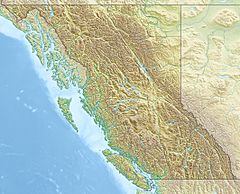Sheslay River facts for kids
Quick facts for kids Sheslay River |
|
|---|---|
|
Mouth of Sheslay River
|
|
| Country | Canada |
| Province | British Columbia |
| District | Cassiar Land District |
| Physical characteristics | |
| Main source | Boundary Ranges Coast Mountains 1,352 m (4,436 ft) 57°54′58″N 132°19′4″W / 57.91611°N 132.31778°W |
| River mouth | Inklin River Stikine Plateau 337 m (1,106 ft) 58°46′34″N 132°5′38″W / 58.77611°N 132.09389°W |
| Length | 150 km (93 mi) |
| Basin features | |
| Basin size | 3,342 km2 (1,290 sq mi), |
| Topo maps | NTS 104J4 Kennicott Lake NTS 104J5 Ketchum Lake NTS 104J16 Porter Landing |
The Sheslay River is a river in British Columbia, Canada. It flows into the Inklin River. A tributary is a smaller river or stream that flows into a larger river.
The Sheslay River joins the Nahlin River to form the Inklin River. The Inklin River is one of the main rivers that flows into the Taku River. The lower part of the Sheslay River forms a border between two flat, high areas called the Taku Plateau and the Nahlin Plateau.
The place where the Sheslay River meets the Nahlin River is where three plateaus meet. These are the Taku, Nahlin, and Kawdy Plateaus. All these plateaus are part of a bigger area known as the Stikine Plateau.
The Sheslay River runs through the traditional lands of the Taku River Tlingit First Nation. These are part of the Tlingit people.
Contents
Where the Sheslay River Starts
The Sheslay River begins in the Cheja Range. This area is part of the Boundary Ranges mountains. It starts near the beginning of the Chutine River and the Stikine Icecap.
The river flows mostly north for about 150 km (93 mi). It then meets the Nahlin River. When these two rivers meet, they form the Inklin River. The end of the Sheslay River is about 145 km (90 mi) northeast of Juneau, Alaska. It is also about 110 km (68 mi) northwest of Telegraph Creek, British Columbia.
River Size and Flow
The Sheslay River's drainage basin covers a large area. A drainage basin is all the land where water flows into a river. This basin is about 3,342 km2 (1,290 sq mi) in size.
The average amount of water flowing in the river each year is 65.3 m3/s (2,310 cu ft/s). This is called its mean annual discharge.
Rivers and Land Around Sheslay
Many smaller streams flow into the Sheslay River. These are called its major tributaries. They include Shearer Creek, Moosehorn Creek, Hackett River, and Egnell Creek. The Samotua River and Tatsatua Creek also flow into it.
The middle part of the Sheslay River is located between the Chechidla Range and Level Mountain. A small community called Sheslay is found where the Sheslay and Hackett Rivers meet.
The lower part of the Sheslay River flows south and west of Heart Peaks. This area is part of the Nahlin Plateau. The very lowest part of the Sheslay River flows between the Taku and Nahlin Plateaus. It joins the Nahlin River to create the Inklin River.
Animals in the Sheslay River
The Sheslay River is home to many types of fish. These include different kinds of salmonids.
Some of the fish you can find are:
- Chinook salmon
- Coho salmon
- Sockeye salmon
- Steelhead trout
- Rainbow trout
- Lake trout
- Dolly Varden trout
- Bull trout
- Round whitefish
Other fish living in the river are coastrange sculpin and slimy sculpin.
See also


